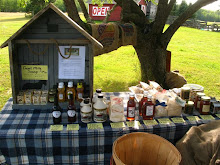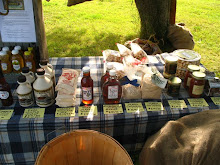Week 1:

* bunch of green onions
* bunch of radishes (white icicle & red globe)
* bag of dried chives
* bunch of rhubarb
* sprigs of mint
July 3, 2008
Week 2:

* sample of goat milk soap
* bunch of green onions
* bunch of radishes (red globe & icicle)
and radish greens
* mesclun salad
* fresh herbs ~ tarragon (1-½” thin leaves on a stem)
~ parsley
~ basil (2 oval curled leaves)
~ sage (green, purple, & golden
~ thyme (tiny leaves on a stem
July 10, 2008
Week 3:

* rhubarb stalks
* bunch of small onions
* bunch of radishes (icicle, red giant,)
and radish greens
* salad mix - Butter crunch
Prizehead
Blushed butter cos
Emerald Oakleaf
Romaine
European mesclun
* cilantro (great in salsa, or chopped up
with tomatoes and onions
* Swiss Chard (red, orange, and yellow, and
can be used fresh in salad)
* Pea pods (wonderful addition to salad or
stir-fry)
* celery stalks
* fresh basil leaves
* fresh lavender sprigs (use in tea, dried for use
in potpourri)
July 17, 2008
Week 4:
* Rhubarb stalks

* bunch of small onions
* Bunch of radishes (icicle, red giant,
and radish greens)
* salad mix - Butter crunch
Prizehead
Blushed butter cos
Emerald Oakleaf
Romaine
European mesclun
* Cilantro (great in salsa, or chopped up
with tomatoes and onions)
* Swiss Chard (red, orange, and yellow,
can be used fresh in salad)
* Pea pods (wonderful addition to salad or
stir-fry)
* Celery stalks
* Fresh basil leaves
* Fresh lavender sprigs (use in tea, dried for
use in potpourri)
July 24, 2008
Week 5:
* Oregano
* bunch of small onions
* salad mix - Butter crunch
Prizehead
Blushed butter cos
Emerald Oakleaf
Romaine
European mesclun
* Kohlrabi (peel, slice, salt & eat fresh)
* Swiss Chard (red,/ orange,
can be used fresh in salad)
* Pea pods (wonderful addition to salad or
stir-fry)
* Green beans
* Summer squash assortment
*Parsley
July 31, 2008
Week 6:
* Blueberries
* Basil leaves
* Rhubarb stalks (red)
* Small onions
* Salad mix - Butter crunch
Prizehead, Mache
Blushed butter cos
Emerald Oakleaf
European mesclun
Romaine, Endive,
Amish deer tongue
Rouge D’Hiver
Lolla Rosa
* Kohlrabi (peel, slice, salt & eat fresh)
* Zucchini
* New potatoes
* Peas
* Green beans
* Summer squash variety
August 7, 2008
Week 7:
* Blueberries
* 1 lb. carrots
* Onions (yellow, Flat of Italy-purple)
* Zucchini or yellow squash
* New potatoes
* Peas
* 1 lb. green beans
* Summer squash variety
* Cucumbers
* Broccoli
* 1 bulb garlic
* bunch of Celery
* Swiss Chard (looks like rhubarb, can
Be eaten fresh or cooked like spinach)
*Rhubarb stalks (red)
August 14, 2008
Week 8:

* Blueberries
* Carrots
* Onions
* Zucchini or yellow squash
* Potatoes
* Dill
* 1 ½ lb. green beans
* Summer squash variety
* Cucumber
* Bag of lettuce
* 1 bulb garlic
* bunch of Celery
* Anise Hyssop
* Fresh Basil
* Sprigs of lavender
August 21, 2008
Week 9:
* Cabbage
* Carrots
* Onions
* Zucchini or yellow squash
* Potatoes
* Parsley
* Green beans
* Summer squash variety
* Cucumbers
* Bag of salad greens
* Bunch of radishes
* Cherry, yellow pear tomatoes,
small roma tomato
* Fresh Basil
* Fresh Cilantro
August 28, 2008
Week 10:
* Beets
* Carrots
* Onions
* Potatoes
* Green beans
* Summer squash variety
* Cucumbers
* Bag of romaine lettuce
* Bunch of radishes
* Tomatoes
* Cherry, yellow pear tomatoes,
Small roma tomato
* Garlic Bulb
September 4, 2008
Week 11:

* Corn on the cob
* Beets
* Carrots
* Onions
* Potatoes
* Green beans
* Summer squash variety
* Cucumbers
* Bag of salad greens
* Optional bag of Kale, Nero Tuscana Kale, Swiss Chard
* Bunch of radishes
* Tomato variety
* 1 Kung Pao Hot Pepper (eat at your own risk!)
* Crab apples
* Apple variety
September 11, 2008
Week 12:
* Corn on the cob
* Beets
* Carrots
* Leek
* Small Russet Potatoes
* Spaghetti or Butternut Squash
* Eggplant
* Cucumbers
* Bag of salad greens & lettuces
* Celery
* Yellow pear and Cherry tomatoes
* Tomato variety
* 1 Kung Pao Hot Pepper (eat at your own risk!)
* Garlic Bulb
* Crab apples
* Apple variety
* herbs: Basil, Cilantro, English Thyme
September 18, 2008
Week 13:
* Pepper
* Yellow, Patty Pan, or Round Zucchini Squash
* Carrots
* Leek
* Acorn Squash
* Spaghetti or Butternut Squash
* Eggplant
* Cucumbers
* Bag of salad greens & lettuces
* Celery
* Yellow pear and Cherry tomatoes
* Tomato variety
* Small onions
* Radishes (French Breakfast variety)
* Apples
* herbs: Dill, Parsley, Sage
September 25, 2008
Week 14:
* Potatoes
* Yellow, Patty Pan, or 8-Ball Squash
* Carrots
* A Leek or an Eggplant
* Acorn Squash
* Bulb of Garlic
* Bag of Spinach
* Cucumbers
* Bag of salad greens & lettuces
* Celery
* Yellow pear and Cherry tomatoes
* Tomato variety
* Apples (good for baking, applesauce)
* herbs: Parsley
October 2, 2008
Week 15:
* Butternut Squash (let sit on counter a week or
two to ripen fully)
* Yellow or Patty Pan Squash
* Carrots
* A Kung Pao Pepper
* Acorn Squash
* Onions
* Cauliflower (optional)
* Cucumbers
* Bag of salad greens & lettuces
* Rutabaga
* Yellow pear and Cherry tomatoes
* Tomato variety
* Apples (good for baking, applesauce)
* Nero De Tuscana Cabbage (can be used
Fresh, canned, or frozen)
October 9, 2008
Week 16:

* Butternut Squash (let sit on counter a week or two to ripen fully)
* Acorn Squash
* Carrots
* Hot Pepper(s)
* Bunch of Beets
* Parsnip
* Bag of salad greens & lettuces
* Rutabaga
* Yellow pear and Cherry tomatoes
* Tomatoes (let the green ones sit on a table or
windowsill next to an apple to ripen)
* Baking apples
* Eating apples
* Purple Cabbage
* Pineapple Sage (can be used fresh in tea, or dried
for use in Pineapple Upsidedown Cake, Chicken rub, etc.)
* 4 oz. jar Honey
* jar of Pure Maple Syrup
* Sample bar of Goat Milk Soap




































